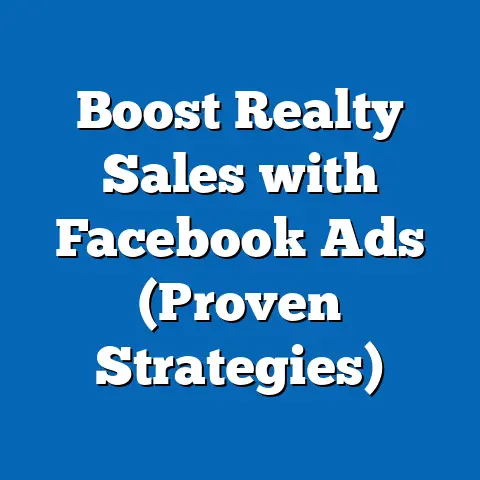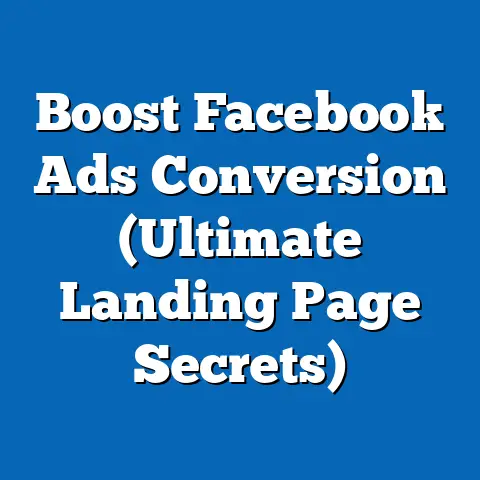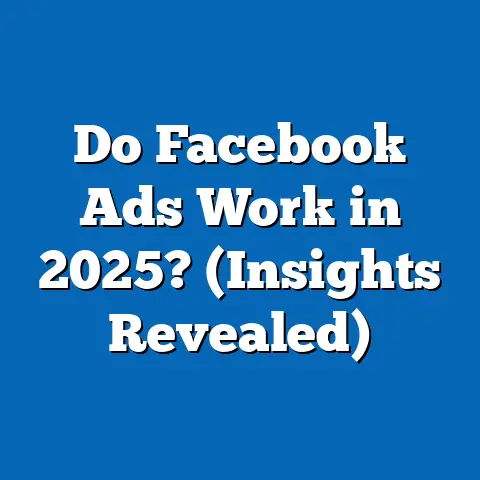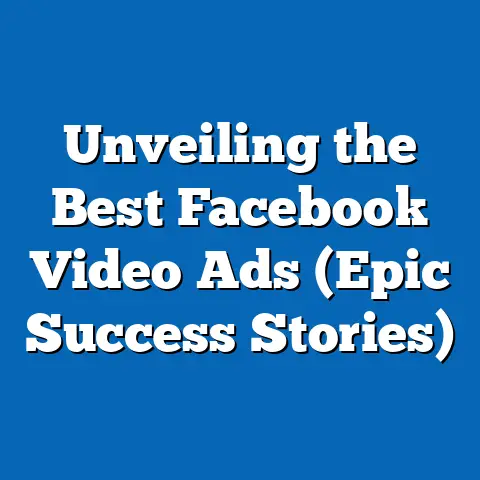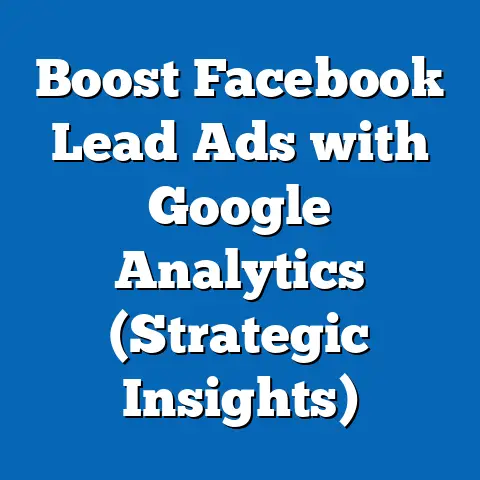Maximize Ad Performance with Facebook API (Expert Guide)
In today’s digital landscape, luxury brands face a unique challenge: how to maintain their aura of exclusivity and prestige while effectively reaching their target audience in a space saturated with noise. Advertising on Facebook, a platform with billions of users, presents both an opportunity and a potential pitfall. To truly thrive, luxury brands must leverage cutting-edge technology and data analytics to ensure their message resonates with the right individuals. This is where the Facebook API comes into play.
I’ve seen firsthand how the Facebook API can transform a struggling campaign into a roaring success. It’s not just about throwing money at ads; it’s about precision targeting, personalized messaging, and real-time data analysis. These are the cornerstones of effective luxury advertising, and the Facebook API provides the tools to achieve them.
This guide will delve into the intricacies of the Facebook API, exploring its various functionalities and demonstrating how it can be harnessed to optimize ad performance for luxury brands. We’ll cover everything from setting up your account to analyzing your results, providing actionable insights every step of the way.
Understanding the Facebook API
The Facebook API, or Application Programming Interface, is essentially a bridge that allows different software systems to communicate with each other. In the context of digital marketing, the Facebook API enables developers and marketers to access and interact with Facebook’s data and advertising platform programmatically. This means you can automate tasks, pull detailed performance reports, and build custom solutions that go beyond the standard features offered in Facebook Ads Manager.
Think of it like this: Facebook Ads Manager is like driving a car with automatic transmission. It’s user-friendly and gets you where you need to go, but it doesn’t offer the same level of control and customization as a manual transmission. The Facebook API, on the other hand, is the manual transmission, allowing you to fine-tune every aspect of your advertising campaigns.
Types of Facebook APIs
Several different types of Facebook APIs cater to various needs:
-
Graph API: This is the core API that allows you to read and write data to and from Facebook. You can use it to access user profiles, posts, pages, and more.
-
Marketing API: Specifically designed for advertising, this API allows you to manage campaigns, ad sets, ads, and reporting. It’s the workhorse for automating and customizing your advertising efforts.
-
Ads Management API: A subset of the Marketing API, this focuses on managing ad accounts, campaigns, and creatives.
-
Business Manager API: Allows you to manage your business assets, such as pages, ad accounts, and people, programmatically.
Graph API: This is the core API that allows you to read and write data to and from Facebook. You can use it to access user profiles, posts, pages, and more.
Marketing API: Specifically designed for advertising, this API allows you to manage campaigns, ad sets, ads, and reporting. It’s the workhorse for automating and customizing your advertising efforts.
Ads Management API: A subset of the Marketing API, this focuses on managing ad accounts, campaigns, and creatives.
Business Manager API: Allows you to manage your business assets, such as pages, ad accounts, and people, programmatically.
For luxury brands, the Facebook API’s significance lies in its ability to enable advanced audience segmentation and personalized marketing strategies. Imagine being able to target individuals based on their purchase history, interests in specific luxury goods, travel habits, and even their engagement with competitor brands. The Facebook API makes this level of granularity possible.
Technical Requirements
Accessing the Facebook API requires some technical know-how, but don’t let that intimidate you. Here’s a brief overview of the requirements:
-
Developer Account: You’ll need to create a Facebook Developer account. This is free and allows you to create and manage your Facebook apps.
-
Facebook App: You’ll need to create a Facebook App within your developer account. This app will be the bridge between your code and the Facebook API.
-
API Keys and Access Tokens: Once you’ve created your app, you’ll receive API keys and access tokens. These are like passwords that allow your app to access Facebook’s data.
-
Permissions: You’ll need to request specific permissions from Facebook to access certain data or perform certain actions. For example, you’ll need the
ads_managementpermission to manage advertising campaigns.
Developer Account: You’ll need to create a Facebook Developer account. This is free and allows you to create and manage your Facebook apps.
Facebook App: You’ll need to create a Facebook App within your developer account. This app will be the bridge between your code and the Facebook API.
API Keys and Access Tokens: Once you’ve created your app, you’ll receive API keys and access tokens. These are like passwords that allow your app to access Facebook’s data.
Permissions: You’ll need to request specific permissions from Facebook to access certain data or perform certain actions. For example, you’ll need the ads_management permission to manage advertising campaigns.
Key Takeaway: The Facebook API offers unparalleled control and customization for your Facebook advertising efforts. Understanding the different types of APIs and the technical requirements for accessing them is the first step towards unlocking its full potential.
Setting Up for Success
Before you can start wielding the power of the Facebook API, you need to lay the groundwork. This involves setting up your Facebook Business account, creating a Facebook App, and understanding Facebook’s advertising policies.
Facebook Business Account
Your Facebook Business account serves as the central hub for managing your Facebook assets, including your pages, ad accounts, and people. If you’re a luxury brand, it’s crucial to have a well-organized and professionally managed Business account.
To set up your Business account:
-
Go to business.facebook.com and click “Create Account.”
-
Follow the prompts to enter your business name, contact information, and website.
-
Claim your Facebook Page and create an ad account within your Business account.
Go to business.facebook.com and click “Create Account.”
Follow the prompts to enter your business name, contact information, and website.
Claim your Facebook Page and create an ad account within your Business account.
Creating a Facebook App
Creating a Facebook App is the next step in gaining access to the API. This app will act as the intermediary between your code and Facebook’s servers.
-
Go to developers.facebook.com and log in with your Facebook account.
-
Click “Create App” and choose the “For Everything Else” option.
-
Provide a name for your app and choose a business account to associate it with.
-
Once your app is created, navigate to the “Add Product” section and select “Facebook Login.”
-
Configure the Facebook Login settings, including your app’s domain and redirect URLs.
Go to developers.facebook.com and log in with your Facebook account.
Click “Create App” and choose the “For Everything Else” option.
Provide a name for your app and choose a business account to associate it with.
Once your app is created, navigate to the “Add Product” section and select “Facebook Login.”
Configure the Facebook Login settings, including your app’s domain and redirect URLs.
After setting up the app, you’ll be able to generate API keys and access tokens. Keep these safe and secure, as they are essential for accessing the API.
Understanding Facebook’s Advertising Policies
Luxury brands must be particularly mindful of Facebook’s advertising policies. These policies cover a wide range of topics, including prohibited content, targeting restrictions, and data privacy requirements.
Here are a few key considerations for luxury brands:
-
Brand Integrity: Ensure your ads align with your brand’s image and values. Avoid using misleading or deceptive tactics.
-
Compliance: Comply with all applicable laws and regulations, including those related to data privacy and advertising standards.
-
Targeting: Be mindful of targeting restrictions, particularly those related to sensitive categories like age, gender, or religion.
-
Transparency: Be transparent about your data collection and usage practices.
Brand Integrity: Ensure your ads align with your brand’s image and values. Avoid using misleading or deceptive tactics.
Compliance: Comply with all applicable laws and regulations, including those related to data privacy and advertising standards.
Targeting: Be mindful of targeting restrictions, particularly those related to sensitive categories like age, gender, or religion.
Transparency: Be transparent about your data collection and usage practices.
Navigating the Facebook Developer Portal
The Facebook Developer portal can seem daunting at first, but it’s a treasure trove of information and resources. Here are some tips for navigating the portal:
-
Documentation: The official documentation is your best friend. It provides detailed explanations of the API’s various endpoints and functionalities.
-
Graph API Explorer: This tool allows you to test API calls directly in your browser. It’s a great way to experiment with different endpoints and parameters.
-
Community Forums: The Facebook Developer community forums are a valuable resource for getting help and sharing knowledge with other developers.
Documentation: The official documentation is your best friend. It provides detailed explanations of the API’s various endpoints and functionalities.
Graph API Explorer: This tool allows you to test API calls directly in your browser. It’s a great way to experiment with different endpoints and parameters.
Community Forums: The Facebook Developer community forums are a valuable resource for getting help and sharing knowledge with other developers.
Key Takeaway: Setting up your Facebook Business account and creating a Facebook App are essential steps for accessing the Facebook API. Understanding Facebook’s advertising policies is crucial for maintaining brand integrity and complying with advertising standards.
Leveraging the Facebook API for Targeting
One of the most powerful aspects of the Facebook API is its ability to provide granular targeting options. For luxury brands, this means being able to reach a highly specific audience of potential high-net-worth individuals.
Custom Audiences
Custom Audiences allow you to target individuals based on your own data sources, such as your customer list, website traffic, or app activity. This is a great way to reach existing customers or potential customers who have already shown interest in your brand.
Here are a few ways luxury brands can use Custom Audiences:
-
Customer List: Upload your customer list to target existing customers with exclusive offers or new product announcements.
-
Website Traffic: Target individuals who have visited your website or specific pages on your website. For example, you could target individuals who have viewed your collection of high-end watches.
-
App Activity: Target individuals who have used your mobile app. For example, you could target individuals who have browsed your app’s catalog of luxury handbags.
Customer List: Upload your customer list to target existing customers with exclusive offers or new product announcements.
Website Traffic: Target individuals who have visited your website or specific pages on your website. For example, you could target individuals who have viewed your collection of high-end watches.
App Activity: Target individuals who have used your mobile app. For example, you could target individuals who have browsed your app’s catalog of luxury handbags.
Lookalike Audiences
Lookalike Audiences allow you to find new potential customers who are similar to your existing customers. This is a great way to expand your reach and find individuals who are likely to be interested in your brand.
Here’s how Lookalike Audiences work:
-
You provide Facebook with a source audience, such as your customer list or website traffic.
-
Facebook analyzes the characteristics of your source audience.
-
Facebook finds new individuals who share similar characteristics.
You provide Facebook with a source audience, such as your customer list or website traffic.
Facebook analyzes the characteristics of your source audience.
Facebook finds new individuals who share similar characteristics.
Luxury brands can use Lookalike Audiences to find individuals who share similar demographics, interests, and behaviors as their existing high-net-worth customers.
Data Analytics and Targeting Refinement
Data analytics plays a crucial role in refining your targeting strategies. By analyzing the performance of your past campaigns, you can identify which targeting parameters are most effective and adjust your campaigns accordingly.
Here are a few metrics to monitor:
-
Reach: The number of unique individuals who saw your ad.
-
Impressions: The number of times your ad was displayed.
-
Click-Through Rate (CTR): The percentage of individuals who clicked on your ad.
-
Conversion Rate: The percentage of individuals who completed a desired action, such as making a purchase or filling out a form.
Reach: The number of unique individuals who saw your ad.
Impressions: The number of times your ad was displayed.
Click-Through Rate (CTR): The percentage of individuals who clicked on your ad.
Conversion Rate: The percentage of individuals who completed a desired action, such as making a purchase or filling out a form.
By analyzing these metrics, you can gain valuable insights into your audience’s behavior and preferences. This information can be used to refine your targeting strategies and improve the performance of your campaigns.
Key Takeaway: The Facebook API provides powerful targeting capabilities that allow luxury brands to reach a highly specific audience of potential high-net-worth individuals. Custom Audiences and Lookalike Audiences are valuable tools for expanding your reach and finding new customers. Data analytics plays a crucial role in refining your targeting strategies and improving campaign performance.
Crafting High-Impact Ads
Creating compelling ad creatives is essential for capturing the attention of your target audience and driving conversions. For luxury brands, this means crafting ads that are visually stunning, emotionally resonant, and strategically targeted.
Elements of a Successful Luxury Ad Campaign
Here are a few key elements to consider:
-
Visuals: Use high-quality images and videos that showcase your products or services in a luxurious light.
-
Copy: Write compelling copy that highlights the unique value proposition of your brand. Use language that is sophisticated and aspirational.
-
Call-to-Action (CTA): Include a clear and concise call-to-action that tells viewers what you want them to do next.
-
Targeting: Ensure your ads are targeted to the right audience.
Visuals: Use high-quality images and videos that showcase your products or services in a luxurious light.
Copy: Write compelling copy that highlights the unique value proposition of your brand. Use language that is sophisticated and aspirational.
Call-to-Action (CTA): Include a clear and concise call-to-action that tells viewers what you want them to do next.
Targeting: Ensure your ads are targeted to the right audience.
A/B Testing and Ad Variations
The Facebook API facilitates A/B testing, which allows you to test different ad elements to determine which perform best. This is a valuable tool for optimizing your ad creatives and maximizing your return on investment.
Here are a few ad elements you can test:
-
Headlines: Try different headlines to see which ones generate the most clicks.
-
Images: Test different images to see which ones resonate best with your audience.
-
CTAs: Experiment with different calls-to-action to see which ones drive the most conversions.
Headlines: Try different headlines to see which ones generate the most clicks.
Images: Test different images to see which ones resonate best with your audience.
CTAs: Experiment with different calls-to-action to see which ones drive the most conversions.
Dynamic Ads and Retargeting
Dynamic ads automatically show the most relevant products to each individual based on their browsing history and purchase behavior. Retargeting allows you to show ads to individuals who have previously interacted with your brand, such as visiting your website or viewing your products.
These strategies are particularly effective for luxury brands, as they allow you to personalize the ad experience and re-engage potential customers who have already shown interest in your brand.
Rich Media Formats
Facebook offers a variety of rich media formats, such as video ads and carousel ads, that can enhance storytelling and brand presentation.
-
Video Ads: Use video ads to showcase your products in action or tell a compelling brand story.
-
Carousel Ads: Use carousel ads to display multiple images or videos in a single ad. This is a great way to showcase a variety of products or highlight different features of a single product.
Video Ads: Use video ads to showcase your products in action or tell a compelling brand story.
Carousel Ads: Use carousel ads to display multiple images or videos in a single ad. This is a great way to showcase a variety of products or highlight different features of a single product.
Key Takeaway: Crafting high-impact ads is essential for capturing the attention of your target audience and driving conversions. A/B testing, dynamic ads, retargeting, and rich media formats are valuable tools for optimizing your ad creatives and maximizing your return on investment.
Analyzing and Optimizing Ad Performance
The final step in maximizing your ad performance is to analyze your results and make data-driven decisions for campaign adjustments. The Facebook API provides access to a wealth of performance data that can be used to gain valuable insights into your audience’s behavior and preferences.
Metrics and KPIs for Luxury Brands
Here are a few key metrics and KPIs to monitor:
-
Return on Ad Spend (ROAS): This metric measures the revenue generated for every dollar spent on advertising.
-
Cost per Acquisition (CPA): This metric measures the cost of acquiring a new customer.
-
Customer Lifetime Value (CLTV): This metric measures the total revenue generated by a customer over their lifetime.
-
Brand Awareness: This metric measures the level of awareness of your brand among your target audience.
Return on Ad Spend (ROAS): This metric measures the revenue generated for every dollar spent on advertising.
Cost per Acquisition (CPA): This metric measures the cost of acquiring a new customer.
Customer Lifetime Value (CLTV): This metric measures the total revenue generated by a customer over their lifetime.
Brand Awareness: This metric measures the level of awareness of your brand among your target audience.
Using the Facebook API to Pull Performance Data
The Facebook API allows you to pull performance data programmatically, which means you can automate the process of collecting and analyzing your results. This can save you a significant amount of time and effort.
Here’s how to pull performance data using the Facebook API:
-
Use the
ads_insightsendpoint to retrieve performance metrics for your campaigns, ad sets, and ads. -
Specify the fields you want to retrieve, such as
impressions,clicks,spend, andconversions. -
Filter the data by date range, demographics, and other parameters.
Use the ads_insights endpoint to retrieve performance metrics for your campaigns, ad sets, and ads.
Specify the fields you want to retrieve, such as impressions, clicks, spend, and conversions.
Filter the data by date range, demographics, and other parameters.
Real-Time Analytics
Real-time analytics allow you to track your ad performance in real-time and respond quickly to market trends and consumer behavior changes. This is particularly important for luxury brands, as they need to be able to adapt to changing consumer preferences and maintain a competitive edge.
Here are a few ways to use real-time analytics:
-
Monitor your ad spend: Track your ad spend in real-time to ensure you’re staying within your budget.
-
Identify underperforming ads: Identify ads that are not performing well and make adjustments to improve their performance.
-
Respond to market trends: Monitor market trends and adjust your campaigns accordingly.
Monitor your ad spend: Track your ad spend in real-time to ensure you’re staying within your budget.
Identify underperforming ads: Identify ads that are not performing well and make adjustments to improve their performance.
Respond to market trends: Monitor market trends and adjust your campaigns accordingly.
Advanced Optimization Techniques
Here are a few advanced optimization techniques to consider:
-
Adjusting Bids: Adjust your bids based on performance insights. For example, you could increase your bids for ads that are performing well and decrease your bids for ads that are not performing well.
-
Ad Placements: Experiment with different ad placements to see which ones generate the best results.
-
Budget Allocations: Allocate your budget to the campaigns and ad sets that are performing best.
Adjusting Bids: Adjust your bids based on performance insights. For example, you could increase your bids for ads that are performing well and decrease your bids for ads that are not performing well.
Ad Placements: Experiment with different ad placements to see which ones generate the best results.
Budget Allocations: Allocate your budget to the campaigns and ad sets that are performing best.
Key Takeaway: Analyzing and optimizing your ad performance is crucial for maximizing your return on investment. The Facebook API provides access to a wealth of performance data that can be used to gain valuable insights into your audience’s behavior and preferences. Real-time analytics and advanced optimization techniques can help you stay ahead of the competition and maintain a competitive edge.
Conclusion
In the competitive world of luxury advertising, simply having a presence on Facebook isn’t enough. You need to leverage every tool at your disposal to ensure your message resonates with the right audience and drives meaningful results. The Facebook API is that tool.
By understanding the API’s capabilities, setting up your account correctly, leveraging advanced targeting options, crafting high-impact ads, and analyzing your performance data, you can unlock the full potential of Facebook advertising for your luxury brand.
I’ve witnessed firsthand the transformative power of the Facebook API. It’s not just about automating tasks; it’s about gaining a deeper understanding of your audience, crafting more compelling messages, and making data-driven decisions that lead to tangible results.
In a competitive luxury market, leveraging data and technology is not just an option but a necessity for sustaining growth and relevance. Embrace the capabilities of the Facebook API to elevate your marketing strategies and connect with your affluent audience more effectively. The future of luxury advertising is data-driven, and the Facebook API is your key to unlocking that future.

